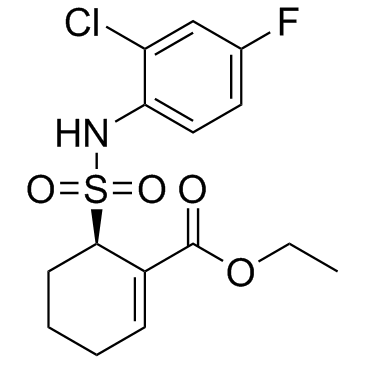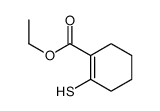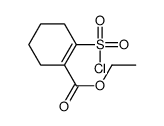| Description |
Resatorvid (TAK-242) is a potent TLR4 signaling inhibitor which selectively inhibits the TLR4-mediated production of cytokines and nitric oxide.
|
| Related Catalog |
|
| Target |
TLR4[1]
|
| In Vitro |
In RAW264.7 cells and mouse peritoneal macrophages, Resatorvid (TAK-242) suppresses lipopolysaccharide (LPS)-induced production of NO, tumor necrosis factor-α (TNF-α), and interleukin (IL)-6, with IC50 of 1.1 to 11 nM. Resatorvid (TAK-242) also suppresses the production of these cytokines from LPS-stimulated human peripheral blood mononuclear cells (PBMCs) at IC50 values from 11 to 33 nM[1].
|
| In Vivo |
Resatorvid (TAK-242) apparently reduces the serum anti-dsDNA levels in both genotype mice. Alternatively, IFN-γ, TNF-α, and IL-1β production is markedly inhibited by Resatorvid (TAK-242), but their concentrations are still greatly higher than those in NS-treated counterparts[2]. Resatorvid (TAK-242) pre-stress administration prevents the accumulation of potentially deleterious inflammatory and oxidative/nitrosative mediators in the brain frontal cortex of rats. Resatorvid (TAK-242) i.v. administration at the beginning of the stress session completely blocks TLR-4 mRNA and protein upregulation after stress exposure[3].
|
| Cell Assay |
RAW264.7 cells are seeded at a density of 3×106 cells/well in six-well culture plate and incubated overnight. After washing with RPMI 1640 medium supplemented with 1% FCS and 10 μg/mL Kanamycin, the cells are stimulated with 5 ng/mL LPS and 1 U/mL IFN-γ in the presence or absence of Resatorvid (TAK-242) (1-100 nM) for the indicated time. Culture supernatants are removed, and total RNA is isolated using the total RNA isolation reagent ISOGEN. Total RNA is reverse transcribed into cDNA by using TaqMan reverse transcription reagents. Quantitative real-time PCR analysis of TNF-α and IL-6 is performed on ABI Prism 7700 using predeveloped TaqMan assay reagents and Universal PCR master mix. Quantitation of mRNA is performed using the comparative threshold cycle method. The highest control level attained by the stimulation (without Resatorvid (TAK-242)) is regarded as 100%, and the levels of control group at other time points and TAK-242-added group are expressed as the percentage of the highest control level[1].
|
| Animal Admin |
Mice[2] Thirty ApoE-/- and thirty wild-type mice on C57BL/6 background (female, 10 weeks old) are fed on a high-fat diet containing 0.25% cholesterol and 15% cocoa butter under standardized lighting conditions (12 h light-dark cycle) and temperature (21±1°C). And mineral water is administered ad libitum. Mice of both genotypes are randomly assigned to LPS or LPS + Resatorvid (TAK-242) or saline administration. LPS (2.5 mg/kg), LPS (2.5 mg/kg) plus Resatorvid (TAK-242) (0.3 mg/kg) and saline are administered respectively by intraperitoneal injection, twice a week for 4 weeks. At the end of experiments, all mice underwent euthanasia with injection of overdose pentobarbital (50 mg/kg). Rats[3] Male outbred Wistar Hannover rats, initially weighing 200 to 225 g, are used. Resatorvid (TAK-242) is i.v. injected in the tail vein at a dose of 0.5 mg/kg immediately after (approximately 10 seconds) introducing the animal to the plastic restrainer. This dose is chosen on the basis of previous in vivo studies reporting its anti-inflammatory/antioxidant and neuroprotective profile in microglia exposed to hypoxia. Dimethyl sulphoxide at a concentration of 0.9% is used as vehicle.
|
| References |
[1]. Ii M, et al. A novel cyclohexene derivative, ethyl (6R)-6-[N-(2-Chloro-4-fluorophenyl)sulfamoyl]cyclohex-1-ene-1-carboxylate (TAK-242), selectively inhibits toll-like receptor 4-mediated cytokine production through suppression of intracellular signaling. [2]. Ni JQ, et al. Role of toll-like receptor 4 on lupus lung injury and atherosclerosis in LPS-challenge ApoE?/? mice. Clin Dev Immunol. 2013;2013:476856. [3]. Gárate I, et al. Toll-like 4 receptor inhibitor TAK-242 decreases neuroinflammation in rat brain frontal cortex after stress. J Neuroinflammation. 2014 Jan 11;11:8. [4]. Wang L, et al. Doxorubicin-Induced Systemic Inflammation Is Driven by Upregulation of Toll-Like Receptor TLR4 and Endotoxin Leakage. Cancer Res. 2016 Nov 15;76(22):6631-6642. [5]. Shibata A, et al. Toll-like receptor 4 antagonist TAK-242 inhibits autoinflammatory symptoms in DITRA. J Autoimmun. 2017 Jun;80:28-38. [6]. Janda J, et al. Resatorvid-based Pharmacological Antagonism of Cutaneous TLR4 Blocks UV-induced NF-κB and AP-1 Signaling in Keratinocytes and Mouse Skin. Photochem Photobiol. 2016 Nov;92(6):816-825. [7]. Krock E, et al. Low back pain and disc degeneration are decreased following chronic toll-like receptor 4 inhibition in a mouse model. Osteoarthritis Cartilage. 2018 Sep;26(9):1236-1246.
|

![(6RS)-6-[N-(2-chloro-4-fluorophenyl)sulfamoyl]cyclohex-1-ene-1-carboxylic acid Structure](https://image.chemsrc.com/caspic/021/340722-43-2.png) CAS#:340722-43-2
CAS#:340722-43-2![1-Cyclohexene-1-carboxylic acid, 6-[[(2-chloro-4-fluorophenyl)amino]sulfonyl]-, ethyl ester Structure](https://image.chemsrc.com/caspic/092/243983-70-2.png) CAS#:243983-70-2
CAS#:243983-70-2 CAS#:54928-91-5
CAS#:54928-91-5 CAS#:1655-07-8
CAS#:1655-07-8 CAS#:243984-26-1
CAS#:243984-26-1 CAS#:243984-25-0
CAS#:243984-25-0 CAS#:64-17-5
CAS#:64-17-5![acetoxymethyl (6RS)-6-[N-(2-chloro-4-fluorophenyl)sulfamoyl]cyclohex-1-ene-1-carboxylate Structure](https://image.chemsrc.com/caspic/059/340722-42-1.png) CAS#:340722-42-1
CAS#:340722-42-1